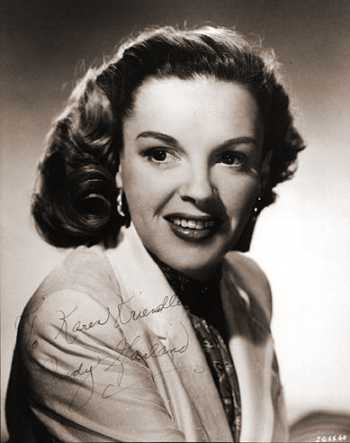
Click to hear Judy Garland's
version of Jolson's songs

Click to hear Judy Garland's version of Jolson's songs |
EVERY SUNDAY (1936) a short film with Deanna Durbin was Garland's first role at M-G-M. Her first major impact on audiences came with her third film, BROADWAY MELODY OF 1938 (1937) in which she sang "Dear Mr Gable". She was then teamed with M-G-M's established child star, Mickey Rooney, a partnership which brought a succession of popular films in the Andy Hardy series. By now, everyone at M-G-M knew that they had a star on their hands. This fact was triumphantly confirmed with her appearance in THE WIZARD OF OZ (1939), in which she sang "Somewhere Over the Rainbow", the song with which she would subsequently always be associated. She won a special Oscar as "the best juvenile performer of the year" for the role which originally had been intended for Shirley Temple.
However, the price and pressures of such fame were high. It wasn't long before she first encountered drugs. Her friends began to notice alarming differences; a gaunt look from severe weight loss and dark - blue circles under her eyes. Besides psychiatric drugs, Garland was introduced to psychoanalysis. Judy decided to start treatment, seeing Menninger associate Dr. Ernst Simmel five mornings a week.
With her personal life firmly on the downward slide towards later disasters, Garland's successful film career now took a further upswing. In 1942 she appeared in FOR ME AND MY GAL then made PRESENTING LILY MARS, THOUSANDS CHEER, GIRL CRAZY (all 1943), MEET ME IN ST. LOUIS (1944), THE HARVEY GIRLS, ZIEGFELD FOLLIES and TILL THE CLOUDS ROLL BY (all 1946).
In 1945 she married Vincente Minnelli, who had directed her in MEET ME IN ST. LOUIS. It was M-G-M's biggest grossing film after GONE WITH THE WIND. In 1946 her daughter, Liza Minnelli, was born. The late '40s brought more film successes with THE PIRATE, EASTER PARADE, WORDS AND MUSIC (all 1948) and IN THE GOOD OLD SUMMERTIME (1949).
Under psychiatrist's orders, she began the first of many stays in psychiatric hospitals. Then in 1949, not yet 27 years old, she was subjected to the violence and electroshock. She was also given hypnosis to "calm her nerves and help her lose weight". In 1951 her marriage to Minnelli finished, and she attempted suicide. Her subsequent marriage to Sid Luft and his handling of her career brought an upturn both emotionally and professionally. She made a trip to Europe, appearing at the London Palladium to great acclaim.
Her film career resumed with a dramatic/singing role in A STAR IS BORN (1954), for which she was unsuccessfully nominated for an Oscar. A straight dramatic role, in JUDGEMENT IN NUREMBERG (1961), for which she was still nominated for an Oscar, enhanced her reputation.
Despite the personal traumas and the professional ups and downs, Judy achieved another huge success with a concert at New York's Carnegie Hall on 23 April 1961, the subsequent album of the concert winning five Grammy Awards (and sold 2 million copies).
Early in 1968, Judy went to London and there married her fifth husband, a 35 - year old discotheque manager named Mickey Deans. She began a three week engagement at a London cabaret, which turned out to be the worst flop of her career. Not only was she habitually late for performances, but her voice frequently cracked and she constantly forgot her lines.
But she seemed to be recovering from the effects of this fiasco when sometime during the night of June 22, 1969, she stumbled in the bathroom of her London apartment. She was found dead in the morning by Deans. The official coroner's verdict attributed her death to an accidental overdose of sleeping pills. But Ray Bolger, Dorothy's Scarecrow friend in THE WIZARD OF OZ, commented: "She just plain wore out." Thousands of bereaved fans jammed the vicinity of the Manhattan funeral home where her body lay in state.
| (Dear Mr. Gable) You Made Me Love You | |
| Toot, Toot, Tootsie, Goo'Bye! | |
| Rock-A-Bye Your Baby With A Dixie Melody |
|
Updated 28 Dec 02 Updated 06 Nov 20 |